Fantasia 2019, Day 3, Part 2: Away
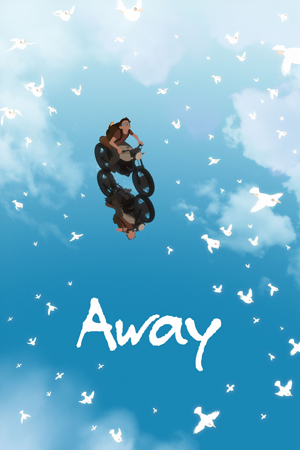 My second feature film of Saturday, July 13, was at the De Sève Theatre. It was the one-man animated feature Away, by Latvian Gints Zilbalodis. Zilbalodis wrote, directed, edited, animated, designed the sound, and did everything else for this 75-minute wordless fable about a young man trying to cross a mysterious island.
My second feature film of Saturday, July 13, was at the De Sève Theatre. It was the one-man animated feature Away, by Latvian Gints Zilbalodis. Zilbalodis wrote, directed, edited, animated, designed the sound, and did everything else for this 75-minute wordless fable about a young man trying to cross a mysterious island.
Before it played came “An Eye For An Eye,” a 17-minute animated short from Poland. Written and directed by Julia Ploch, who adapted her own original comic story, it’s about a hero who vanishes and a youth who tries to seek him out. Both characters are frogs, and the hero, the Red Frog, has disappeared after a quest for the secret knowledge held by the mysterious Great Catfish. It’s a structure a little like Telemachus seeking Odysseus, I suppose, but the result’s different.
We see what happened when the Red Frog finds the Catfish, the wounds he suffers and his Jonah-like travails, and get a glimpse of the wisdom he’s learned. That gives the conclusion a powerful heft. The story’s well-told and unpredictable, in (what looks like a) hand-drawn style, sketchy but sinuous, with an understated use of colour. Banners and panels appear on screen with secondary events within them, picture-in-picture storytelling. Dialogue’s replaced by word balloons holding pictures. In a technical sense, it’s a fascinating and effective way to adapt a graphic novel, and the overall story’s a solid and well-structured creation.
Away begins with a youth parachuting into a desert. He’s chased by a shadowy giant to a green oasis in some hills. There, the youth finds a map, a motorbike, and a small curious yellow bird. The map shows us that he’s at one end of an island, and there’s a town at the other end. The youth chooses to get on the bike, with map and bird, and race past the giant. Chased by the dark shape, who is less a physical threat than an entropic force that drains life and energy, the boy tries to reach the town at the far end of the island, passing many strange places along the way.
The movie’s made in an expressive, simplified CGI style with bright but harmonious colours. It’s fluid, with expressive movement and particularly beautiful moments in its sense of scale. The film makes extensive use of long takes, particularly notable when they come in the form of long gliding camera moves tracking across swathes of landscape. Still there’s a constant sense of movement and, dramatically, of a chase — of the need for the youth to keep moving forward. While characters do sometimes feel as though they’re skating over the landscape, or interact with other physical objects in an uncanny fashion, it’s easy to view this as part of the dream-world and dream-logic of the film.
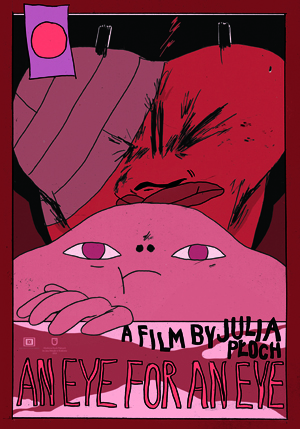 Divided into chapters, Away builds a world that intrigues not because of rational connections between its various parts but because the different stages of the youth’s journey have a consistent feel. Without ever becoming either a high fantasy or complete surrealism, it builds a memorable world with a balance of realistic geography and unexpected discoveries. The youth does not find something magical at every turn. But he finds enough beauty and strangeness that one is kept intrigued. As I say, there is a dream-logic to the island, so that it’s tonally of a piece even when the interaction between its parts are minimal.
Divided into chapters, Away builds a world that intrigues not because of rational connections between its various parts but because the different stages of the youth’s journey have a consistent feel. Without ever becoming either a high fantasy or complete surrealism, it builds a memorable world with a balance of realistic geography and unexpected discoveries. The youth does not find something magical at every turn. But he finds enough beauty and strangeness that one is kept intrigued. As I say, there is a dream-logic to the island, so that it’s tonally of a piece even when the interaction between its parts are minimal.
The lack of dialogue goes some way to building this tone. Watching the youth there’s an odd sense that not only does he not have another human to speak to, he may not in fact be entirely verbal. He doesn’t talk to himself, or hum, or mutter, or (that we can see) move his lips as he thinks. It’s as if he’s more a part of the animal world, and indeed his co-stars are animals: the yellow bird, a turtle, a group of cats. Spectacular moments come from the different ecosystems on the island, different settings with their own kinds of beauties.
The movie’s conscious of this beauty, and of the visual power of the hills and green valleys and desert, but is fundamentally about the boy’s struggle to reach the only town in the island. It’s a film about a quest for connection, then, and perhaps about the attempt to outrace the kind of bleakness (in the form of the giant) that can lead an individual into isolation. It’s easy to read the film as fable or myth; and like a myth it’s possible to see a range of meanings in it that may or may not be intended. This is not a weakness but a strength, and the archetypal structure of the boy’s journey is a useful framework on which to hang resonant and surprising incidents.
A visually spectacular scene at a bridge across a misty abyss or an unexpected encounter with a group of cats by a geyser with unusual powers feel as though they have a latent power beyond the parts they play in the story of the film. There are signs of human activity in these settings, but not a living, speaking culture. The human world’s shaping the environment, but it’s animal life that inhabits these places. They’re human enough to speak to us, but inhuman enough to demonstrate how far the boy has to go.
The different stages and things found therein also help establish the boy’s personality and individuality. I noted in my review of Vivarium that it’s tricky to get individuality in an everyperson character, but Zilbalodis demonstrates how to do it here. What the youth does with the strange places he finds, how he goes about exploring and understanding and ultimately using them, is specific to him. We learn about him through action, which is a good way to go about it.
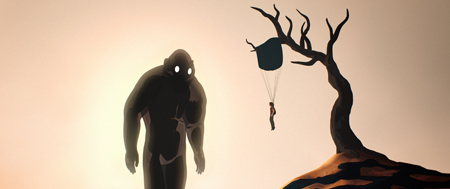 (It does have to be said that this kind of character work has to make up for what is to some extent lacking in the animation style. Facial expressions are not vivid, and close-ups don’t establish emotion particularly well. Character motion and design are well-judged, though, which helps.)
(It does have to be said that this kind of character work has to make up for what is to some extent lacking in the animation style. Facial expressions are not vivid, and close-ups don’t establish emotion particularly well. Character motion and design are well-judged, though, which helps.)
In any event, the film builds nicely, and the climax is well-planned. exciting, and I thought quite satisfying.
Zilbalodis finds a good balance between tying up various aspects of the film — including a sub-plot with a minor character that reflects on the main plot — and leaving things unexplained for the audience to fill in for themselves. He ends the movie in precisely the right spot. We’re left with a powerfully effective adventure narrative that lets us establish the meaning of things for ourselves.
We’re seeing more and more one-man animation features these days. Away is a worthy addition to the likes of Battledream Chronicles and Nova Seed. I’d imagine in this case the story’s also so idiosyncratic that it might have been easier for Zilbalodis to get his vision across in a pure form without having to worry about explaining it to collaborators. In any event, the film’s powerful enough that audiences can take from it what they want while also being specific enough to have a distinct identity and distinct themes. It’s child-friendly, if you have a child who’s comfortable with dialogue-free visual storytelling, but is more accurately described as truly all-ages. I hope it finds its audience.
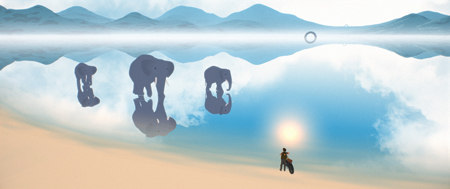 After the film Gints Zilbalodis came out to take questions (as usual, what follows come from my hand-scrawled notes). The first question was about the electronic score to the film, and whether Zilbalodis had made it himself. He said yes, he’d made it on a laptop as he doesn’t play an instrument. It’s minimalistic, he observed, and you know it’s not produced by real instruments. He built a library of tracks, saw what fit where, tweaked the film to fit the music and also tweaked the music to fit the film. He has worked with a composer on short films in the past, but it didn’t work out this time due to scheduling and various other reasons.
After the film Gints Zilbalodis came out to take questions (as usual, what follows come from my hand-scrawled notes). The first question was about the electronic score to the film, and whether Zilbalodis had made it himself. He said yes, he’d made it on a laptop as he doesn’t play an instrument. It’s minimalistic, he observed, and you know it’s not produced by real instruments. He built a library of tracks, saw what fit where, tweaked the film to fit the music and also tweaked the music to fit the film. He has worked with a composer on short films in the past, but it didn’t work out this time due to scheduling and various other reasons.
Asked about the editing rhythms, avoiding jump scares and sudden flurries of cuts while keeping a firm propulsive pace, and how it worked with the music, he said he didn’t want the music to mimic the story but to be in sync with important parts, developing an emotion or idea. He noted that in family animation music tends to change every ten seconds from funny to scary; he said he feels it’s important to give the audience time to feel the music. Asked how long it took to make the film, he said three and half years from first having the idea. Asked what drove him over this time, he said he didn’t think of subtext, but after he was finished realised it was a reflection of filmmaking and that the hero was similar to him in his isolation and the way he faced negative emotions, stress, and pressure.
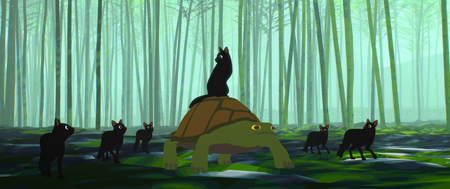 Asked about the boy’s intention toward the town, Zilbalodis said he’d wanted the character to have a clear motivation. Specifically, wanting to get home and connect with society, a theme reflected also in the final choice of the bird who accompanies him. Film is in a sense a way to connect with others, and share experiences and stories. The town, he felt, was not too happy or too sad, and the way the characters in the town paralleled other figures in the film should leave it ambiguous.
Asked about the boy’s intention toward the town, Zilbalodis said he’d wanted the character to have a clear motivation. Specifically, wanting to get home and connect with society, a theme reflected also in the final choice of the bird who accompanies him. Film is in a sense a way to connect with others, and share experiences and stories. The town, he felt, was not too happy or too sad, and the way the characters in the town paralleled other figures in the film should leave it ambiguous.
Asked whether he developed images first or story (specifically images of a herd of elephants relatively early in the film), he said it was organic. He knew the story beats, so could create images and then figure out where they’d fit. With respect to the elephants, for example, he knew he wanted an uplifting moment where it seemed the boy had escaped. Zilbalodis felt he could work this way without storyboards because he worked alone. If he’d had a large crew he would have needed to plan things out, making them hard to change. As a result, it was faster to work his way.
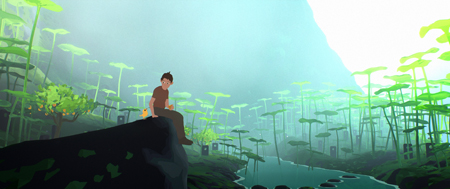 Asked about his influences in adventure stories, and specifically whether he was influenced by video games in the way the chapters seemed similar to levels of a game, he agreed there were similarities and influences. He said that the movie was rendered in real time, so was similar to a video game. He reflected that 10 or 15 years ago it would have been an insult to say it looked like a game, but now games have matured. He acknowledged inspiration from games in the way his character had no dialogue, the way he explored, and the way audiences could work out backstory from the sight of ruins.
Asked about his influences in adventure stories, and specifically whether he was influenced by video games in the way the chapters seemed similar to levels of a game, he agreed there were similarities and influences. He said that the movie was rendered in real time, so was similar to a video game. He reflected that 10 or 15 years ago it would have been an insult to say it looked like a game, but now games have matured. He acknowledged inspiration from games in the way his character had no dialogue, the way he explored, and the way audiences could work out backstory from the sight of ruins.
Asked about the software he used, he said it was Maya Viewport. This was not how the software was meant to be used, as it was designed for previews only, but with Maya he could see the film in real time as he made it. Traditional CG animation is more of a guessing game in which it takes 5 minutes to fully render a frame. Technology, he noted, now allows filmmakers with small budgets and not-so-good computers to make films.
Asked what he’s working on now, he said he was making another dialogue-free feature, Flow, based on one of his short films, “Aqua,” but would have to overcome his fear of water as the story took place in a setting where the whole world is flooded. (There is a preview online.)
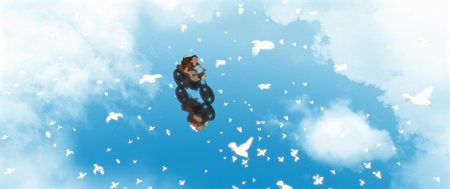 Asked if his skills had evolved in three and a half years, he said he learned a lot. He made the movie chronologically, starting at the beginning and going through to the end, and by the time he’d finished he’d realised the first chapter was of significantly poorer quality than the last. Having deleted the original files, he had to go back and totally remake it, at which point it ended up much better. He also learned he needed to have restrictions, as for example in showing more with fewer cuts rather than hyper-kinetic editing. Finally, asked about an image at one point of daisies blossoming, he said he wanted to have an image there contrasting a peaceful scene with the tension of the uncanny monster approaching — the tension of dark and light, along with an animal unaware of oncoming doom.
Asked if his skills had evolved in three and a half years, he said he learned a lot. He made the movie chronologically, starting at the beginning and going through to the end, and by the time he’d finished he’d realised the first chapter was of significantly poorer quality than the last. Having deleted the original files, he had to go back and totally remake it, at which point it ended up much better. He also learned he needed to have restrictions, as for example in showing more with fewer cuts rather than hyper-kinetic editing. Finally, asked about an image at one point of daisies blossoming, he said he wanted to have an image there contrasting a peaceful scene with the tension of the uncanny monster approaching — the tension of dark and light, along with an animal unaware of oncoming doom.
That was the last film of the day for me. I’d be back at Fantasia on Sunday, for another and quite different animated movie.
Find the rest of my Fantasia coverage from this and previous years here!
Matthew David Surridge is the author of “The Word of Azrael,” from Black Gate 14. You can buy collections of his essays on fantasy novels here and here. His Patreon, hosting a short fiction project based around the lore within a Victorian Book of Days, is here. You can find him on Facebook, or follow his Twitter account, Fell_Gard.